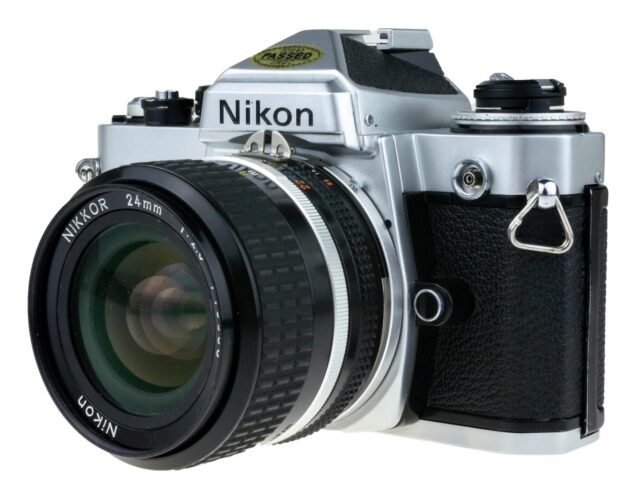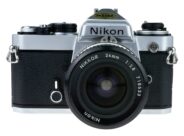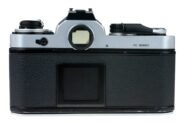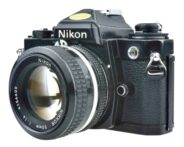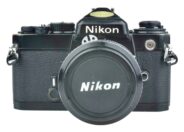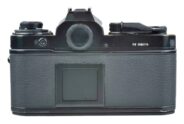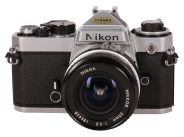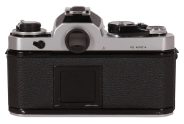Announced
Production status
System
Nikon F system cameras
- Nikkorex F
- Nikkormat EL
- Nikkormat ELW
- Nikkormat FS
- Nikkormat FT
- Nikkormat FT2
- Nikkormat FT3
- Nikkormat FTN
- Nikon D3
- Nikon D3s
- Nikon D3X
- Nikon D4
- Nikon D4s
- Nikon D5
- Nikon D6
- Nikon D600
- Nikon D610
- Nikon D700
- Nikon D750
- Nikon D780
- Nikon D800
- Nikon D800E
- Nikon D810
- Nikon D850
- Nikon Df
- Nikon EL2
- Nikon EM
- Nikon F
- Nikon F100
- Nikon F2
- Nikon F3
- Nikon F4
- Nikon F5
- Nikon F6
- Nikon FA
- Nikon FE
- Nikon FE10
- Nikon FE2
- Nikon FG
- Nikon FG-20
- Nikon FM
- Nikon FM10
- Nikon FM2
- Nikon FM2/T
- Nikon FM3A
- Nikon N2000
- Nikon N2020
- Nikon N4004
- Nikon N4004S
- Nikon N50
- Nikon N5005
- Nikon N55
- Nikon N60
- Nikon N6000
- Nikon N6006
- Nikon N65
- Nikon N70
- Nikon N75
- Nikon N80
- Nikon N8008
- Nikon N8008S
- Nikon N90
- Nikon N90S
Nikon FE
35mm MF film SLR camera • Discontinued
Specification
| Format: | |
| 35mm full frame | |
Film type: | 135 cartridge-loaded film |
| Nikon F [46.5mm] | |
| Shutter: | |
Type: | Focal-plane |
Model: | Electronically controlled |
Speeds: | 8 - 1/1000 + B |
| Exposure: | |
Exposure metering: | Through-the-lens (TTL), open-aperture |
Exposure modes: | Aperture-priority Auto |
| Manual | |
| Physical characteristics: | |
Weight: | 590g |
Dimensions: | 142x89.5x57.5mm |
Manufacturer description #1
Nikon FE offers critically accurate, electronic exposure automation and special, interchangeable focusing screens to expand the intrinsic versatility of the Nikon FM model, which it complements. Its exposure memory lock, selective exposure compensation control, and special SB-10 thyristor flash facilities further validate its position as a uniquely-advanced compact automatic with full motor drive capabilities in the Nikon tradition.
The Nikon FE signifies a dramatic advance in 35mm capabilities. Exceptionally small and light, it blends electronic automation with a seemingly endless array of creative options including interchangeable Nikkor lenses, motor drive, and interchangeable focusing screens for far-reaching versatility. Perhaps most important, all these advances are achieved in the classic Nikon tradition of rugged, reliable construction and quick, comfortable handling which have made Nikon the acknowledged quality standard for 35mm SLR photography.
Advanced Nikon Electronics
In both automatic and manual exposure modes, shutter speeds are timed electronically by a unique Nikon-developed monolithic Integrated Circuit for unexcelled speed, accuracy and consistency. Meter data is relayed to shutter mechanism by exclusive Nikon Functional Resistance Element (FRE), incorporating gold-plated electrical contacts and a highly stable variable resistance element for lasting reliability. Pioneered by Nikon,this innovative; solid-state precision assures shutter and meter performance consistent with the most exacting professional requirements.
Automatic Exposure Control
With shutter speed dial in 'A' position, the FE meter transmits exposure information to the electronically-controlled shutter, which automatically sets the precise speed for optimum exposure. Offering full-aperture operation with all AI-Nikkor lenses and compatible accessories, this versatile aperture-priority automation gives creative depth-of-field control as well as accurate, automatic operation at taking aperture through uncoupled lenses, extension tubes and bellows , and other image-forming attachments including microscopes and telescopes.
Center-Weighted SPD Meter
Dual Silicon Photo Diodes provide virtually instant response, ideal for all automatic exposure requirements including motor drive applications. Wide-ranging sensitivity extends from EV 1 to EV 18 with ASA 100 film and f1.4lens; films from ASA 12 to ASA 4000 may be employed. Based on proven Nikon center-weighted measurement, the meter observes the entire image area, but concentrates more than half of its sensitivity in a central 12mm area (defined by a circle in the finder). Assures consistently accurate exposures whether camera is held horizontally or vertically. Dual SPD sensors assure unexcelled uniformity of center-weighted readings, equally consistent from camera to camera - a special advantage to professionals employing multiple camera bodies.
Exposure Control Options
Offers four additional methods in addition to automatic at full and taking aperture:
- Memory lock: Convenient control (activated by dual-purpose self-timer lever) instantly "memorizes" automatically determined exposure setting, ideal for backlighting or other special situations;
- Exposure Compensator: Provides selective exposure adjustment from - 2 to + 2 EV (e.g. 1/4 to 4X normal exposure) in 0.5 EV increments - particularly valuable in motorized applications (EV - 1 to + 1 when meter is set at extreme of ASA range);
- Match-Needle: Maintains through the lens center-weighted metering even in manual operation. Simply align two needles in finder by manually adjusting aperture or shutter speed as indicated by the meter;
- Full Manual: Select any desired aperture and marked speed (from 8 seconds to 1/1000th second) for full manual control while maintaining electronic accuracy. Additionally, shutter operates mechanically at M90 (1/90th sec.) and B independently of battery for reliable back-up assurance.
All-Metal Vertical Shutter
Special electronically-timed shutter travels upwards, incorporates a unique sealed braking system for reliable and extra-quiet operation. With shutter speed dial in 'A' position, speeds are steplessly and continuously variable from 8 seconds to 1/1000th second; alternatively, shutter may be set to any of 14 marked speeds within this range for electronically controlled manual use. 'B' and 'M90' (1/90th sec.) settings are also provided, both mechanically controlled. Special 'lock' prevents inadvertent movement from 'A' position. Shutter is powered by two S-76 1.5v silver oxide batteries, with provision for manual, mechanically-governed operation at 'M90' or 'B' even if batteries become depleted.
Full-Information Finder with Interchangeable Focusing Screens
Eye-level pentaprism finder shows large, brilliant image with all exposure information: (a) complete shutter speed display; (b) shutter speed in use (automatic or manual); (c) aperture of AI-Nikkor lens (reflected by Nikon Aperture Direct Reading System); (d) center-weighted meter area; and (e) LED ready- light in eyepiece for Nikon SB-10 electronic flash. Eyepiece rim is rubber-cushioned.
Special, interchangeable focusing screens provide added benefits to the FE photographer. The 3 screens are: Type K (standard), an all-purpose screen combining split-image rangefinder with microprism collar and overall matte Fresnel field; Type B, suitable for telephoto and close-up requirements, with 12mm matte spot and overall matte Fresnel pattern; and Type E, excellent for micro/macro, multi-exposure, and architectural work, with inscribed horizontal/vertical lines on overall matte Fresnel surface with 12mm central matte spot.
Multi-Function Advance Lever
Patterned after that on Nikon cameras built for U.S. Apollo Space project; winds film and shutter and counts exposure in single 135 deg. stroke. Moving lever 30 deg. from flush position activates meter; pressing lever flush turns meter off and locks shutter, preventing inadvertent exposures and battery drain. Special electrical contacts activate meter and shutter internally when Nikon Motor Drive MD-11 is in use.
Precise Multiple Exposure System
Convenient top-mounted control permits any number of exposures on same frame, in critical registration. May be employed with or without motor drive. Frame counter disengages during multi-exposure operation.
Instant Depth-of-Field Preview
Permits accurate observation at taking aperture via simple one-touch control on camera front. Operates whether camera is in automatic or manual mode. May also be used for obtaining automatic exposure control with auto diaphragm lenses which are not meter coupled.
Variable-Delay Cancellable Self-Timer
Triggers shutter after selected interval (up to approx. 10 sec.); may be 'cancelled' without making exposure. Same lever also activates exposure "Memory Lock" when pushed towards lens.
LED Battery Check
Press button for instant, accurate verification of battery strength, easy to see even in dimmest light - an important advantage in assuring correct meter/shutter operation.
Professional Film Flatness System
Unique Nikon multi-point design assures true film flatness via oversize pressure plate, extra-long film rails, anti-bellying roller, cassette stabilizer, and emulsion-side-out winding for optimum image sharpness.
Motor Drive Capabilities
Nikon FE accepts Nikon Motor Drive MD-11 without modification, for automatic or manual operation in single, continuous, or multiple exposure modes at rates to 3.5 shots per second, according to shutter speed. Easily-attached motor features integral, anatomical handgrip with built-in shutter button and provision for automatically-timed or remote-controlled operation.
Motor attaches via a convenient, knurled screw; special electrical contacts on motor interface with matching contacts on camera base to activate FE electronic shutter and meter system. Using 8 1.5v AA alkaline batteries, approximately 100 36-exposure film rolls are accommodated. Selector permits either single-shot or continuous-burst operation; in continuous mode, firing rate is automatically determined by shutter speed in use. MD-11 (Product No. 101) accepts Nikon Modulite (ML-1), a transmitter/receiver set which activates motorized FE camera at distances to 200 feet via unique modulated-light beam (may be 'bounced' indoors if required); Nikon Wireless Remote Control Set (MW-1), for remote activation at distances to approx. 2300 feet via 80mw CB impulse; and Nikon Intervalometer (MT-1), for time-lapse photography at predetermined intervals as long as 8 minutes.
Special Capabilities with Nikon SB-10 Thyristor Flash
SB-10 is specially designed to couple with FE shutter for automatic flash photography. With camera in automatic mode, switching unit on automatically programs shutter for correct synch at electronically-controlled 1/90. LED ready-light in finder eyepiece lights up when SB-10 is recycled and shutter control is set to A or any calibrated speed from 8 seconds to 1/125th (the highest X-synch). If speed higher than 1/125 is selected, ready-light blinks intermittently as warning signal when camera meter is turned on. SB-10 provides automatic flash exposure accuracy at choice of two lens apertures and distances to 20 feet, with possible recycling times faster than 1 second, according to distance. Other Nikon FE facilities include safety hot shoe (activated only when unit is in place), accepting all standard hot shoe-mount units for cordless operation, and PC outlet, threaded for screw-in Nikon flash cords (also accepts conventional PC cords).
The SB-10 is additionally compatible (without automatic shutter programming or eyepiece ready light coupling) with other Nikon cameras with standard ISO type hot shoe contact. Guide No. 80 for ASA 100 film. Color-coded for automatic operation at choice of apertures (f4 and f8 with ASA 100), at distances to 20' or 10' respectively. Energy saving Thyristor circuitry gives 160 to 1000 flashes on 4 AA alkaline batteries, according to distance. 40° X 56° coverage covers field of 35mm Nikkor lens; accessory Wide Adapter (SW-2) increases to 48° X 67° for 28mm lens field. Measures 1.5 X 3.1 X 3.9", weighs 9.5 oz. less batteries. Nikon SB-10 thyristor Flash, Product No. 280.
Nikon FE is supplied both in satin chrome finish (Product No. 1621) and professional black finish (Product No. 1625). The FE accepts the same cases, motor drive, and other Nikon accessories presently available for the companion Nikon FM model.
Manufacturer description #2
CAMERA TYPE: Compact automatic electronic 35mm SLR with through-the-lens Dual Silicon Photo Diode metering, interchangeable lenses, finder screens, and accessory Motor Drive.
LENSMOUNT: Stainless-steel Nikon bayonet accepts all reflex-viewing Nikkor lenses 6mm-2000mm and all Nikon-mount accessories. Flange/film distance 46.5mm. Automatic diaphragm coupling.
EXPOSURE CONTROL: Automatic through-the-Iens, with aperture priority; manual match-needle control with aperture or shutter priority.
METER SYSTEM: Two Silicon Photo Diode cells accurately concentrate more than half of their sensitivity on central 12mm area shown by circle in finder; operates at full aperture with all AI-Nikkor lenses; stop-down measurement with non-AI lenses, attachments, or instruments. Automatic maximum aperture indexing with all AI-Nikkor lenses.
METER RANGES: ASA 12-4000; EV 1 to 18 (with ASA 100 film and f1.4 lens). Full-aperture coupling range: f1.2-f32.
SHUTTER: Electronically-timed, all metal vertical-travel focal plane; speeds B, 8, 4, 2, 1, 1/2, 1/4, 1/8, 1/15, 1/30, 1/60, 1/90, 1/125, 1/250, 1/500, and 1/1000th second in manual mode; continuously variable 8 - 1/1000th second in automatic mode. Shutter operates at B or M90 (1/90th second) in manual mode even if battery is depleted.
FLASH SYNCHRONIZATION: "X" synch at "B" and 8-1/125th second; "M" synch at "B", 8 - 1/30th second. Automatic flash synch changeover and eyepiece ready light activation with Nikon Thyristor Flash SB-10.
FLASH CONTACTS: Built-in hot shoe with automatic safety switch and special contact for SB-10 flash; single PC outlet accepts Nikon screw-in or conventional PC cords.
VIEWFINDER: Built-in pentaprism finder with - 1.0 diopter eyepiece; information display includes complete shutter speed scale with indicators for speed in use in automatic and match-needle operation, under/over exposure, auto/manual signal, also selected lens aperture with all AI-Nikkor lenses through Nikon Aperture Direct Readout (ADR) system. Eyepiece contains LED ready-light for use with SB-10 flash.
FOCUSING SCREEN: Nikon Type K Screen (supplied) with 3mm-diameter split-image rangefinder, 1mm microprism circle plus overall matte Fresnel area; interchangeable with optional Types B and E screens, all specially-designed for exclusive use with FE.
REFLEX MIRROR: Oversize instant-return type with special pneumatic damping mechanism. Mirror is mounted on durable low mass titanium for extra smooth operation.
FILM LOADING: Multi-slotted easy load take-up spool, hinged back with safety lock and additive automatic-reset exposure counter for fast loading.
FILM TRANSPORT: Single-stroke lever advances film, winds shutter, switches meter on, and counts exposures in 135° action, may be left at "ready" position 30° from camera body to activate meter; when folded flush, lever turns meter off and locks shutter button.
FILM REWIND: Rewind-release button on camera baseplate; fold-out rewind crank pulls up to open camera back, after safety catch is released. Operates with motor drive attached. Special safety lock prevents back from being opened during rewind.
MULTIPLE EXPOSURE CONTROL: By moving control on camera top while operating film transport lever; also operates with MD-11 motor drive.
BATTERY TYPE: Two 1.5v silver oxide batteries (Eveready S76 or equivalent) power meter and shutter; LED battery tester built in.
OTHER FEATURES: Depth-of-field preview; stainless steel reinforced neckstrap eyelets; built-in self-timer with variable delay to approximately 10 seconds (may be 'cancelled' before exposure); memo holder on camera back stores film carton tab or other data.
Similar cameras (4)
35mm full frame • Manual focus • Film • Singe-lens reflex • Nikon F mount
| Model | Shutter | Metering | Modes | Year |
|---|---|---|---|---|
| Kiev-17 aka Киев-17 |
M, 1/1000 | -- | M | 1978 ● |
| Kiev-19 aka Киев-19 |
M, 1/500 | TTL • WA | M | 1985 ● |
| Kiev-19M aka Киев-19М |
M, 1/500 | TTL • OA | M | 1988 ● |
| Kiev-20 aka Киев-20 |
M, 1/1000 | TTL • OA | M | 1983 ● |
